A couple of weeks ago we decided on a multiplayer miniature Napoleonic game in 15mm scale. There is great fun in two teams trying to beat each other with individual players taking care of parts of the historical armies, in this case brigade generals and the units under their command. Discussions, planning and orders in a social context with some beer and snacks. The game was umpired and the players knew very little of what was to unfold. There was also a twist as the victory conditions could be changed by the Austrian players after a few turns.
The historical setting was the beginning of the battle of Ebelsberg on the 3rd of May 1809 between the French with some Bavarian allies and Austrian armies. Following Archdukes Charles declaration of war and disastrous invasion of Bavaria, Napoleon followed up by crossing the border to Austria. General Hiller was retreating with parts of the Kaiserlich-königliche Armee south of the Danube towards Vienna with the French in hot pursuit. The army stopped to rest at the town of Ebelsberg and a rear guard was set up under Vincent to await Schustekh’s brigade that have been delayed. The original victory condition was simple. If the Austrian players can get Schustekh off the board intact they would win. But I decided on an unhistorical option. The Austrian players can opt for a full scale battle transforming a brief holding action into an attempt to give the French a bloody nose outside town. Hiller certainly had this option but instead the army was passively sliced to pieces by the aggressive general Massena until the Austrian high command woke up, the French rampaging through town. Massena on the other hand need to catch Schustekh or simply maul their opponents if they decide to make a serious stand. The armies are about equal in strength if the Austrians commit the whole army although the French have an edge in cavalry and artillery. On the other hand the there are some terrain that can be used defensively. In quality the French are better off but the battle is interesting since there are some really solid Austrian units around, for example a reserve of grenadier battalions. When it comes to leadership the French force however outshine their opponents but then again the commander Hiller is probably the best there is to find among corps commanders or should we say the least bad and a legend, Radetsky, is on hand to lead one brigade. It is however likely that the Austrian commanders will act overcautious and drag their feet. We did not have all the historical units but did our best with what we had.
Deployment.

The battlefield and game board consisted of the fields in front of Ebelsberg with two roads to Linz and Walls. Ebelsberg is across a bridge over river Traun just outside the board to the left in the photo above. It is crucial for the Austrian players to hold the road fork as it serves as bridgehead for the rearguard actions and it is the point where they can retreat off the board if they decide to run. There is a small village, Klein München, with a walled church along the left edge lining the Walls road. The other shorter road to Linz pass through Abdecker’s wood and leads to the right side of the board exiting next to a prominent hill.
The Austrian rear guard at Ebelsberg consisted of two brigades under Josef Radetsky and Josef Hoffmeister respectively under the overall command of old Karl Vincent. Radetsky’s force is a light and fast moving avant-garde brigade and Hoffmeister’s a standard infantry brigade. Some of the units and one of the generals are of fine quality. Lets check out the details.
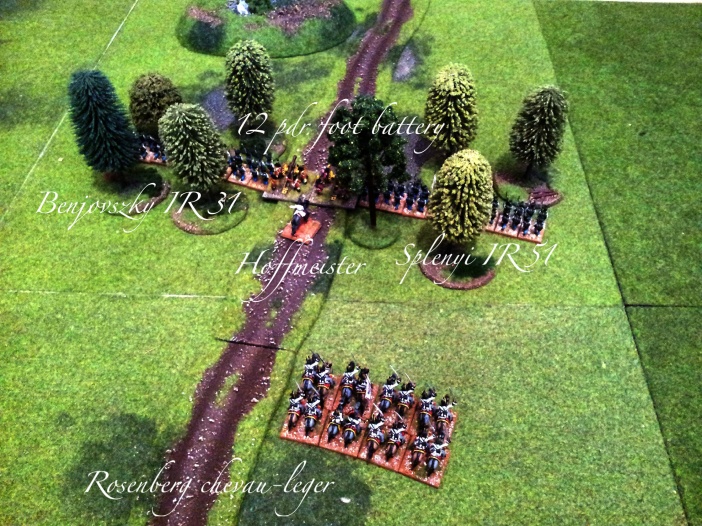
Hoffmeister’s brigade is setup in a rather strong defensive position inside the Abdecker’s wood on both sides of the roads to Linz. Two of the better “Hungarian” infantry regiments of the time originating from Transylvania was infantry regiment 31 Benjovszky and 51 Splenyi. Both of some renown, Benjovszky draw German recruits from the eerie mountain towns and Splenyi a mix of hardy Rumanians and Szeklers from the countryside. They had prepared a hasty defence by cutting down some trees to give them a rudimentary breastwork. Right on the road is a battery of heavy 12 pdr guns. In reserve to the rear is a light cavalry regiment, the Rosenberg chevau-léger. Unfortunately Hoffmeister is an uninspiring and passive leader not unlike most of the Austrian commanders of the time. He lacks positive combat modifiers if he leads from the front and is likely to fail some command rolls when he try to move his brigade. Hoffmeister is however this day destined for some epic achievements but more on that later. To the rear at the road fork between the brigades is general Vincent who can race forward to help one of the two brigades under his command.
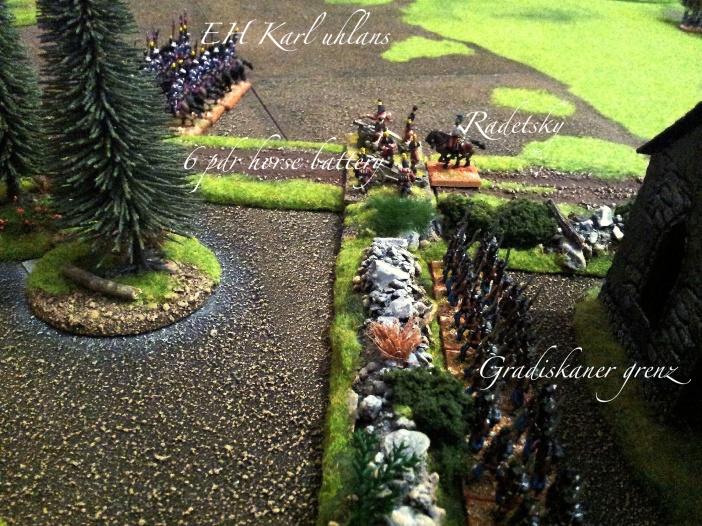
On the Austrian left flank Radetsky was covering the road to Walls. His infantry, Gradiskaner grenz, is defending the church and can be very hard to root out. The Croatians of the grenz infantry used to guard the mountain ridges on the border to the Ottoman empire. They were fierce fighters and experts in skirmishing and ambush, this unit can move in a flexible “open” formation and harass the enemy. They excel in this kind of warfare but if pressed into operating like ordinary line infantry they will likely be disappointing. In game terms they perform bad when forming line, assault column, mass and square. But in defending the church their tenacity and fighting spirit can be a real asset. The lance armed Erzherzog (EH) Karl uhlans was in a forward position overlooking the road and a light horse artillery provided some additional firepower. Radetsky himself is an excellent leader that will become a legend in the future and inspire the music in “Radetsky march” by Johann Strauss sr, if he survives this debacle so to speak.
10:00 Horses, lots of horses!

No sign of Schustekh but at 10 o’clock a large body of French light cavalry burst onto the board. Verdammt! This is the vanguard of Massena’s corps under the command of the dynamic Jacob Marulaz. 3rd and 4th chasseurs à cheval, 8th hussars and an allied Bavarian regiment, the 1st dragoons, backed by a light Bavarian horse battery. All four are fine cavalry regiments but the red jacketed 8th hussars must be held in a tight reign since they are very aggressive and likely to charge even in disadvantageous situations. The Bavarian regiment have drawn veteran recruits from a disbanded heavy cavalry regiment and include many a veteran so they are on par with the French. Marulaz surveys the situation and decides to stay out of musketry range. The Austrian battery barks and the first horsemen in 3rd chasseurs fall to terrifying bouncing round shots but nobody decide to gallop off. They have seen the horrors of Napoleonic combat before. The battle have started.
10:30 Marulaz shifts left.
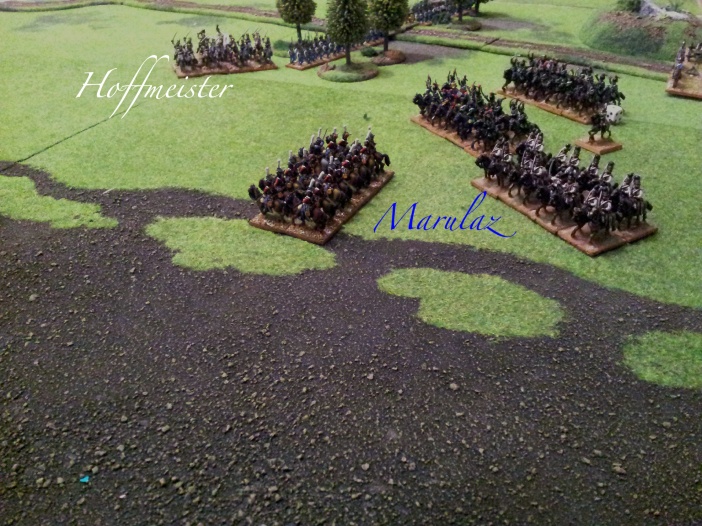
Marulaz thinks for a moment. A direct assault with light cavalry into the woods is out of the question and a dismounted advance in front of all that firepower is equally bad. Light cavalry is armed with carbines but against the volleys of infantry in line they stand small chance. Splitting the command is an option but command will be severed and individual regiments will likely drag their heels or in case of the fire-eating 8th hussars charge headless into the enemies. Marulaz decides to move his entire force around the woods and shift left to threaten the road fork and grab opportunities as they come along. The Bavarian horse battery that have just deployed must mount their cannons without firing a shot. Vincent watches the French move and speed forward to take direct command of Rosenberg chevau-léger to insure that they do as intended. The Austrian cavalry move up to the flank of the Austrian infantry but they are outnumbered 4 to 1. To march the infantry out of the rather strong position is tempting but they are needed to shield the road to Ebelsberg. Radetsky on the other flank decides to help and sends EH Karl uhlans towards the distant woods to help but the excellent general fails his command roll and the uhlans move with a snails pace.
11:00 Damn, where is Schustekh?
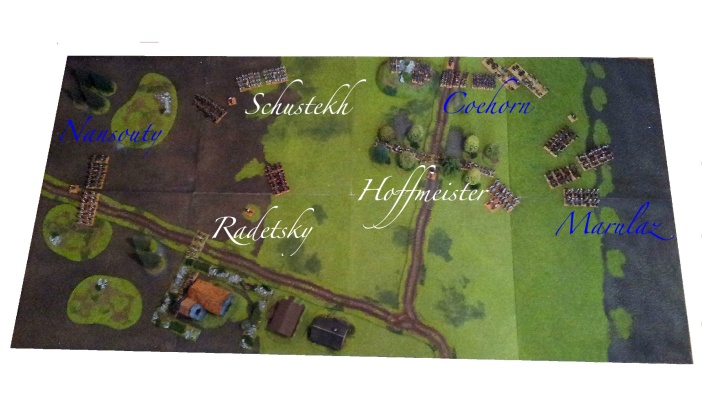
Soon things turn from bad to worse for the Austrians. Instead of Schustekh lost force a French infantry brigade enters the map along the Linz road, General Louis Jacques Coëhorn leading the veterans of Tirailleurs Corses [Corsicans], 17th Léger, 21st Léger and a heavy battery. From the direction of Walls there are dust banks as Nansouty’s cavalry brigade gallops onto the gameboard. Elite armored heavy shock cavalry – 1st carabiniers and 2nd cuirassiers. Just about when the Austrians give up hope the lost brigade of Schustekh’s is sighted. Coming in from an unexpected direction between the French forces. He has two german infantry regiments, 14 Kleber and 59 Jordis, in addition to one of the finest light cavalry of the Austrian army ; Stipsicz hussars in their light green shakos. Now the umpire steps in. The Austrian players can try to get Schustekh’s infantry across the board intact for a win and that is was happened in history but they can also choose to call on General Hiller and reserves for a chance to beat the French in a pitched battle. They know additional French forces are at hand but not how big they are and where they will enter. The Austrian players think for quite some time. They are clearly worried as it seems like the units are to few to insure Schustekh’s withdrawal. On the right they need to hold of the fast moving force of Marulaz and on the left they need to delay Nansouty’s heavy cavalry but they only have three light cavalry regiments as the church and woods, that are good defensive positions, are to be held by the infantry to steady the line. The Austrians finally decides to offer a pitched battle. There will be blood.
11:30 Hiller is cheated on the historical goose liver.
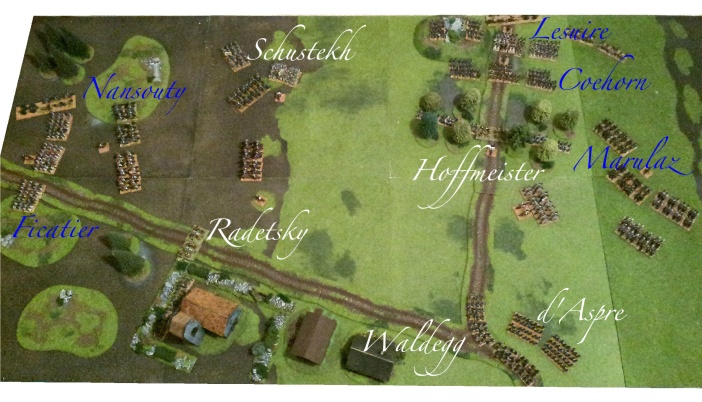
At the Schloß Ebelsberg general Hiller is just about to sink his teeth into the goose liver and enjoy some excellent wine brought up from the cellar when in a very unusual way he decides to check out that rumbling cannon fire that have been going on for an hour. Upon seeing a French force converging on the road fork he in an even more unusual way acts with great speed and decides that there have been enough retreats and that the time has come to show the frogs what Austrian steel is worth. Summoning his staff he orders his best infantry in the form of grenadiers under Constantin s’Aspre and the untrained militia from Vienna under Josef Reinwald Waldegg to support the forward positions. “This is where we make a stand!” Meantime two more French infantry brigades is sighted, Florentin Ficatier and Joseph Lesuire bring on six more french infantry regiments supplemented with two additional heavy artillery batteries. Finally the effective French overall commander André Massena enters and decides on a very aggressive stance. As a man who have risen through the ranks by his his own merits he frowns at the lethargic old nobles on the other side of the line. Massena is certainly capable to move the army into favorable positions. The order of battle is fixed and shown below.
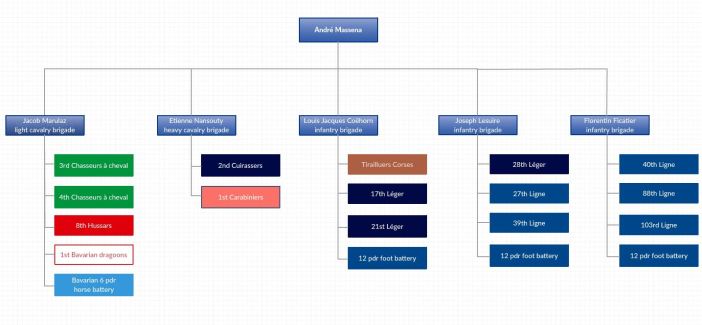

All in all 9 infantry, 6 cavalry and 4 batteries. Massena, Marulaz, Nansouty and Coëhorn are excellent leaders with positive modifiers in tactical combat but all are dynamic and able to march their troops fast and steady them in combat.
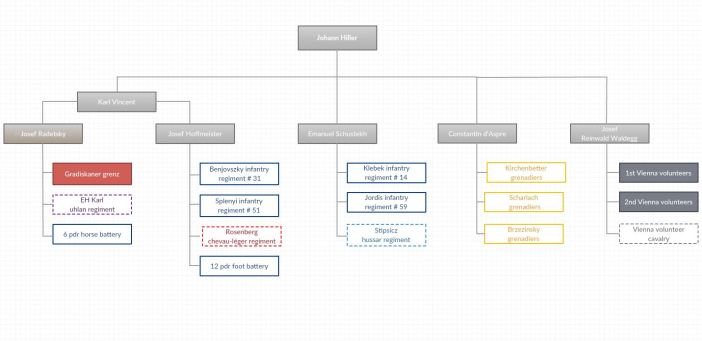

All in all 10 infantry, 4 cavalry and 2 batteries. Radetsky is an excellent leader. Hiller and Schustekh are OK and the rest are, if one are to be honest, a rather sorry bunch.
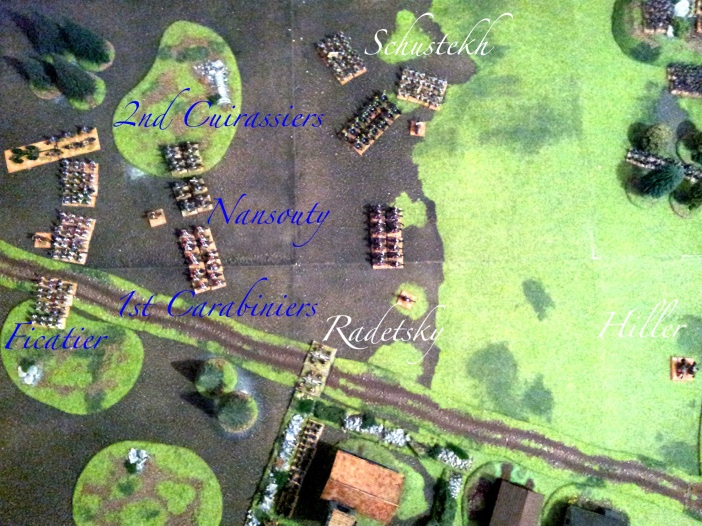
On the Austrian left Nansouty’s French heavy cavalry turns left away from the church and go towards Schustekh at full speed, the idea is to attack the Austrians and thus make it impossible for them to march and join the Austrian main force building up at the road fork. A risky move even though they are first class troops. The newly arrived infantry from Ficatier’s brigade are left behind and cannot support them. The light Austrian horse battery at the church send a few misdirected shots in the direction of the cavalry.

Coëhorn advance in assault columns for a frontal attack on Hoffmeister’s Transylvanian regiments in Abdecker’s wood. They are met by musketry salvoes and the heavy battery exchange their round shots for canister. The fire is a disappointment for the Austrians but all three regiments in Coëhorns brigades are reduced. Tirailleurs Corses taking the worst in their central position flanked by the two léger. The French form a battery consisting of the heavy foot battery and Marulaz Bavarian horse artillery. Austrian losses are small but they start to brace for a french assault next turn.
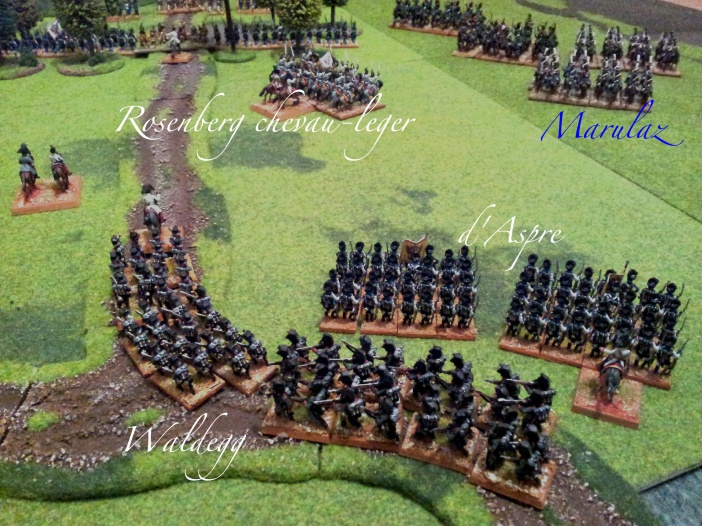
Vincent is in direct command of Rosenberg chevau léger and he backs off slightly to insure that they do not get charged by the numerically superior French. In front of them are the 3rd and 4th Chasseurs á cheval. At the road fork the Austrian reinforcements start to enter. Hiller decides to march d’Aspres’s elite grenadiers towards Marulaz to check the advance of the light cavalry with the Vienna volunteers safely following the road behind them. There are however problems and the Austrian generals seem confused (failed command rolls). Putting the the strongest element of the army, the grenadiers, to cover the road also proves to be a grave error that the Austrian players will regret.
12:00 Massena: En avant!
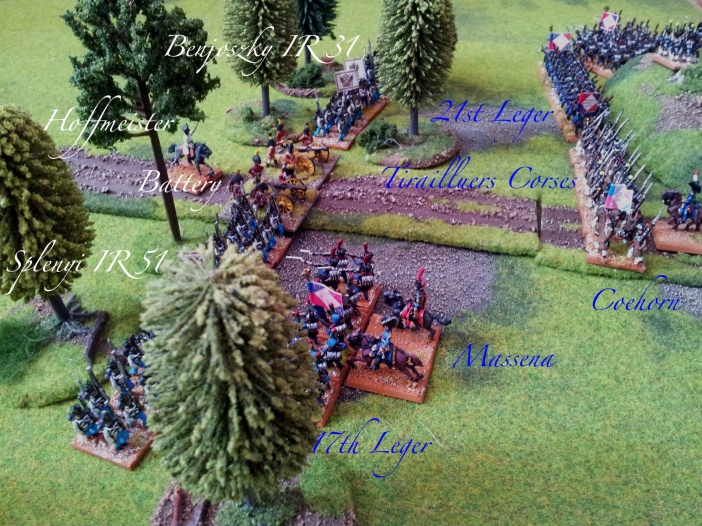
Coëhorns units are ordered forward. The 21 Léger and Tirailluers Corses change formation to line to maximise firepower and Massena himself take a risk and lead the 17th Léger forward in assault column to engage in melee. The Austrian fire is however shattering and the 17th wavers and stops unable to advance against the wall of smoke and fire. They even lose stragglers that start to run in the direction opposite to the commanders intention. Not even Massena himself can stop them. It seems Abdecker’s wood will be a challenge to carry from these sons of Vlad.
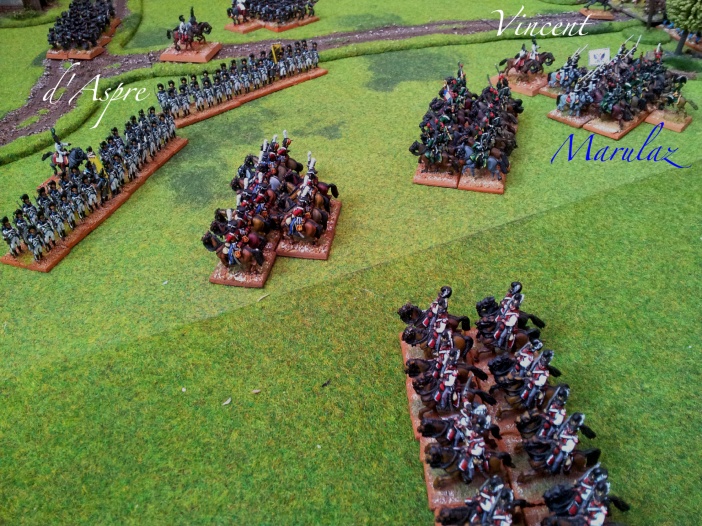
Marulaz is stopped by the grenadiers, he orders his three leftmost regiments out of musketry range but the 8th hussars lingers and are caught by a salvo losing 1/4 of their strength in minutes. Better maneuver and be happy with attention from the best part of the Austrian army as they now cannot be used in other parts of the battlefield. The 3rd Chasseurs however engage in a swirling melee with Vincent and the Rosenberg chevau-léger, hard to tell which will get the upper hand.
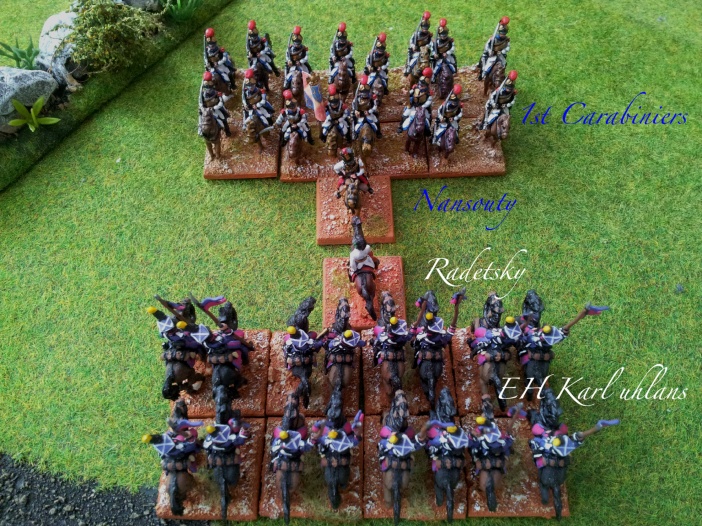
On the Austrian right things look dire. Schustekh must be extricated but the French elite heavy cavalry bear down on them. Radetsky takes a grim decision and lead the uhlans in a desperate head on charge at the carabiniers. Radetsky is a splendid leader but the result is catastrophic and the armor clad horsemen cut like a warm knife through butter. The shattered rest of the lancers retreat, Radetsky swearing over his hopeless situation.
12:30 Radetsky and Vincent killed in action.

Action heats up all along the front with no less than four cavalry charges and intense combat between Hoffmeister and Coëhorn around Abdecker’s wood now dubbed hornet’s nest by the french infantrymen. 2nd Cuirassiers attack Klebek IR 14. The Austrians take a risk and remain in line formation, a safer option would be forming square. They receive the charge with vigour leaving lots of dead horsemen in front them and the cuirassiers that was hoping for an overrun have to retreat. When trying to get away they are hit by another salvo and the dice decide that their loss is gruesome the armor plating not saving them from the lead storm. The 1st Carabiniers under direct command of Nansouty charge the rests of EH Karl uhlans. The uhlans are shattered and Radetsky is cut down! Jordis IR 59 take revenge and fire a devastating salvo at the victorious carabiniers. Schustekh really bites back and Nansoutys brigade is in shambles. Lesuire with three infantry regiments, 28th Léger, 27th Ligne and 29th Ligne, who was behind Coëhorn have however been ordered right over the prominent hill to squeeze Schustekh’s command. Another desperate Austrian cavalry charge is ordered and Stipscz hussars hit the 28 Léger but are unable to shift them and take the greater loss. It seems hard to attack fresh infantry with cavalry. The combat between Rosenberg chevau léger and 3rd Chasseurs is finally decided. The austrian regiment is destroyed and Vincent killed, the second general to fall in a matter of minutes. The 3rd Chassurs have however suffered terrifying losses and will play no further part in the battle. It is clear that the Austrians light cavalry is used to halt the french moves but their gallantry come at a price and the Austrians are running out on fast flexible assets. Likewise the French heavy cavalry is spent but their goal to stop Schustekh’s move towards the other Austrians is achieved.
Massena again tries to take Abdecker’s wood but the french are halted. The combat reverts to a terrifying attritional fire duel between Hoffmeister and Coëhorn. The Austrians around the road fork try to advance, their goal to drive Marulaz away and help Hoffmeister but they move slowly. Generals Waldegg and d’Aspre are unsure of the situation, sense danger and demand support on their flanks (i.e. the fail their command rolls again). Hiller is in rage and send sharp notes containing the words “imbecill”, “coward”, “court martial” and “fire squad”.
When Ficatiers brigade, 40th, 88th and 103rd Ligne, marches of against Schustekh and it is clear that the church in Klein München is not a primary goal the Gradiskaner grenz smartly march out and take up position along the road forming a skirmish line. The Croatians start to harass the 103rd with long range rifle shots that will lead to great loss in the coming hours. The densely packed French infantrymen will have to endure.
13:00 Hiller’s quagmire

While Schustekh and Hoffmeister are hard pressed in their forward positions Hiller try to press things at the road fork with his two unwilling subcommanders. The grave mistake to let the grenadiers face Marulaz light cavalry begins to tell. A better option would have been to let the Vienna volunteers protect the build up area in a defensive formation. They could have anchored the Austrian right in squares supported by their weak cavalry contingent. Now the grenadiers slowly advance and Marulaz backs off, Austrian resource wasted.

Waldegg meanwhile try to get forward but every move is checked. The 1st Vienna volunteers advance but due to their poor morale they have to adopt a defensive mass formation when threatened by the 4th Chasseurs a cheval. In a desperate moment the Vienna volunteers cavalry are ordered to chase the cavalry off and clear the road but the untrained horsemen are duly routed, shocked by the grim realities of war. Marulaz is clearly playing his cards well keeping big parts of the enemy occupied with small losses. He can attack when he wants to and move around freely now when there is no enemy cavalry around.
13:30 Schustekh and Hoffmeister give up

After bravely beating off the elite cuirassiers and carabiniers Schustekh in vain try to escape but is surrounded and forced to form up for a last desperate defence. He can at least bind up a good part of the french infantry for another half our. His brigade is then shattered and the general taken prisoner. The only surviving cavalry in the Austrian force, Stipsicz hussars, watch their fate and then withdraws to a position near the church.
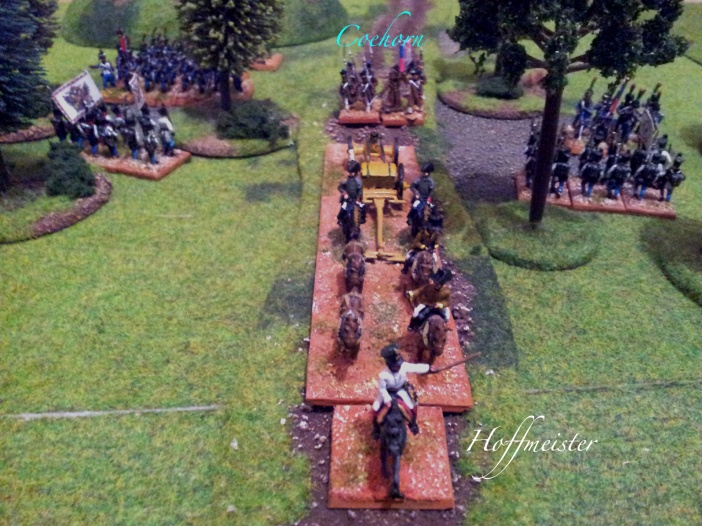
In Abdecker’s wood Hoffmeister have held off the enemy for four hours and inflicted crippling losses on two French regiments, the veteran Tirailluers Corses and 17th Léger. Wisely he decides to save the artillery while there is still some time. The fresh 39th Ligne from Lesuire’s brigade and the only usable regiment in Coëhorns burdened brigade, 21 Léger, finally clear the woods. Hoffmeister might be up for promotion. His abilities clearly better than expected.
14:00 Defensive stance

With the forward positions broken Hiller takes some time to put whats left in a wide arc with grenadiers and volunteers intersected by the retreated batteries. There is even possible to have a small grenadier reserve ready to step forward. The Gradiskaner grenz go back to the church and anchor the left. Meanwhile the French move forward but it will take them another hour to get into contact with this last defense line.
14:30 Formation of a great battery

In preparation for the final assault Massena looks over his remaining units. 6 regiments seem fit to continue the fight. He decides to use Ficatier’s two fairly fresh regiments, the 40th and 88th Ligne, to root the Croatians out from the church and the other four to break Hiller. Lesuire’s 3 regiments, the 28th Léger, 27th Ligne and 39th Line and Coëhorns only remaining regiment, the battered 21st Légere. The key to victory, however, is concentrated artillery. Soon they begin a terrifying bombardment aiming mainly at the shaky volunteers. The Austrians try to reply but they are not only outnumbered, ammunition levels are dangerously low.
15:00 Not beaten yet

Ficatier moves up to the church, Frenchmen falling every meter to accurate rifle fire from the rather formidable bastion. The 40th Ligne goes into line to maximize firepower while the 88th Ligne try to assault the Croatians behind the church wall. The French start to waver and at this point the gallant Stipsicz hussars deliver an unexpected shattering flank charge. The French general wrongly counted on the cavalry being outside charge range. 88th Ligne rout throwing muskets and shakos to the ground. Ficatier find it impossible to renew the offensive, his regiments to tired and reduced. Hiller watch in his spyglass and in a prosaic voice remarks: “A small success is better than no success at all”. Left flank safe.
15:30 – 16:30 Final assault
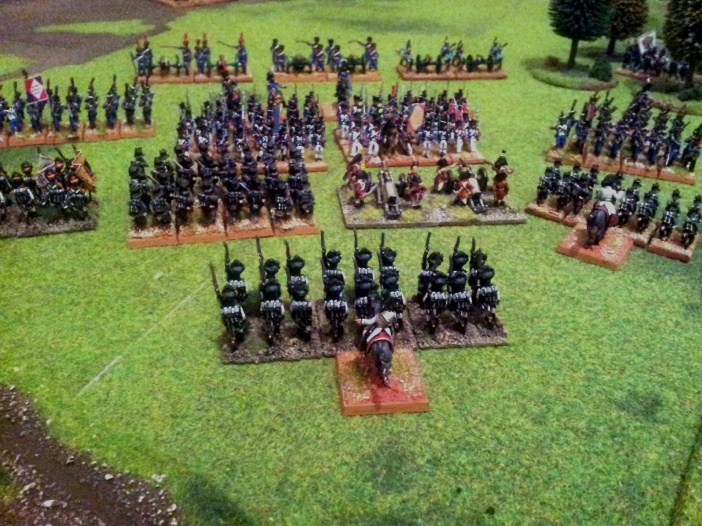
It is time for the final assault and the french move in towards the center avoiding the strong Brzezinsky and Sharlach grenadiers. The combat is short and when the bombarded Volunteers are soundly beaten and both batteries overrun the Austrians launch their last reserve, Kirchenbetter’s grenadiers, at the French spearhead. The outnumbered grenadiers fail to break the French and the Austrians retreat the Volunteers dissolving. Hiller withdraws his last units, Brzezinsky and Sharlach grenadiers off the map as further resistance is futile. French victory!
Massena sighs when he look out over the corpse ridden fields and decides to send an aide-de-camp to parley with the defiant Croats in the church. Enough blood in one day. Maybe he can talk them out of it?
Discussion
It seems like the Austrians will have a really tough time trying to beat the French outside Ebelsberg. One can better have the players change sides for a rerun and see if occurrences differ. The Austrians where defeated piecemeal by a more mobile enemy that used superior numbers in cavalry to fix the Austrians in unfavorable positions. The Austrian light cavalry did their best in gallant but futile charges, mid game they were spent. French casualties was however heavy and the Austrians proved that they can stand up to the French regiment for regiment if one excludes the shaky volunteer regiments that proved to be a liability. Hoffmeister’s heroic defense of the woods was capable and he saved the artillery for further use. Schustekh’s handling of the “tall boys” in the heavy cavalry regiments and the Gradiskaner grenz also shines this dark day from an Austrian point of view. The key to victory for the French was Marulaz who proved to be a real pain with his fast moving force able to pick the favorable combats he wanted to. Maybe it is also better to have cavalry concentrated in brigades the French way than in a supporting role spread across the infantry brigades? The effect of concentrated artillery fire ensured a successful final assault for Massena. For the battle to be more interesting you probably have to add a few units to the Austrian army since their leaders seem to make them a bit worse than they are.
Awesome AAR and beautiful pictures!
LikeLiked by 1 person
Thanks Gunnar!
LikeLike
Late to the party but this was a really enjoyable AAR. Great write up and beautiful miniatures. /Mattias
LikeLike
Thanks Mattias! Better late than never. 😉
LikeLike
Warfare is a fascinating subject. Despite the dubious morality of using violence to achieve personal or political aims. It remains that conflict has been used to do just that throughout recorded history.
Your article is very well done, a good read.
LikeLike
Thank you! A good read is A History of Warfare by John Keegan. His conclusion are interesting. War is a cultural phenomena and the irrational outcome of a failure in politics and diplomacy. Since culture is mutable a future without war is possible.
LikeLike